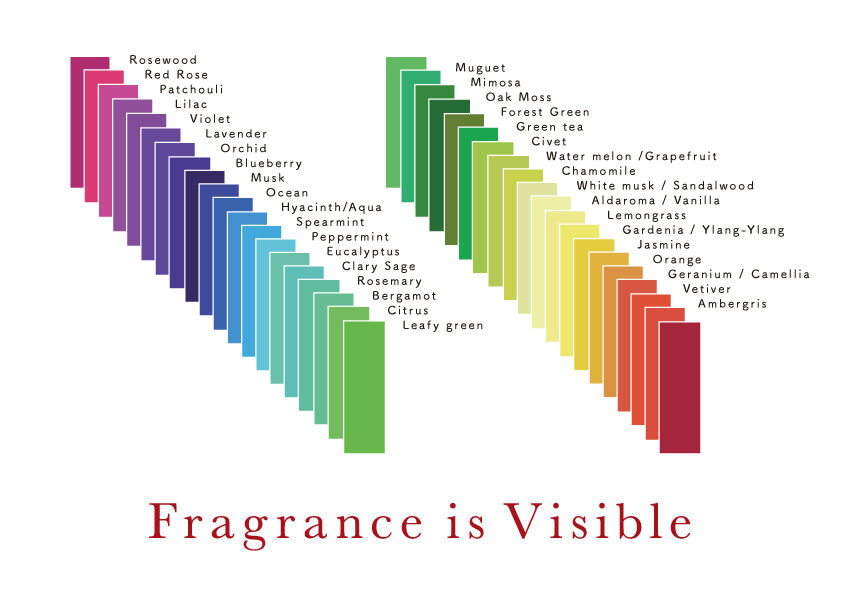Hello everyone!
In this issue, I would like to talk about the theme of sensing fragrance through the five senses.
Fragrance is more than just “smelling”. This is a bit of a philosophical approach.
“Fragrance is Visible” is the fifth installment of FRAGRANCE LAB.BLOG, brought to you by fragrance manufacturer ART LAB.
Fragrance is Visible
Fragrance is Visible? What does that mean? You may be thinking. Fragrance is invisible in a literal sense.
However, there is a deep insight in this phrase. The art of Kodo(Japanese incense ceremony) in the Heian period (794-1185) has the expression “listening to the fragrance,” which is called “Monkou.”
Kodo is blind smelling a scent and guessing what it is, and the guessing part is “Monkou,” which is discribed as listening to the scent. Even though, the senses are used differently, its meaning is the same as our phrase “Fragrance is Visible”, seeing the scents. Both of them are expressed as using senses to deeply observe and understand. We also have the expression “Watch and grasp”, which means understanding what you are watching without knowing what it actually is.
In fact, the phrase, “Fragrance is Visible” inspired me to step into the world of fragrance.
Each scent material has its own color and I learned to create fragrances according to the method of using the colors of scents.

Fragrance, Color, and the Achromatic System
Although some French perfumers create fragrances by sensing color palette in scents, I believe that no one has ever made a system of creating fragrance by assigning a color to every material.
This might sound overstating, but what I learned from this nearly unknown master of the art of fragrance was truly an artistic approach.
My teacher, who first created the basic concept of combining aromatics and chromatics(color) “The Achromatic System”, has long gone, but before he died, he told me that I would be his last student, and that was the moment I decided to devote my whole life to taking over his work.

However, I later realized that I had only received the very basics of his teaching during the four years with him, and over the next ten years, I expanded the scope of the system through self-teaching. And even now, I continue my training.
Back then, I ran around planning fragrance products and developing an unknown market for them while doing sales work during the weekdays. On weekends, I was at my mentor’s house for one-on-one training.
I sometimes reminice the time I spent with my mentor, who was a chemist and also an owner of a fragrance company, as if our conversation exchanges were like riiddles which led me to self-reflect.
What we can see, and what we cannot see
“Form is emptiness, and emptiness is form”
This is a Buddhism phrase meaning that all things in the world are void of substance, and that what is void is everything in the world. This is a well-known phrase in Heart Sutra.
My mentor often used this phrase, as I later realized that he must have percieved this phrase to mean that “Fragrance is visible.”
Us human beings usually receive visible things as real entities.
In other words, I think we tend to disregard what we cannot see, but I was deeply moved by the idea that things we can see have no substance, though it is wrong to think there is no substance in what we cannot see.

Scent Materiel (recipe)
The aromatic materiel (recipe) has colors just like paints, so first take the appropriate shade of matériel on a palette.
Then, the fragrance is prepared on a white canvas just as painting a picture, so that the image of the scenery can be directly captured in the fragrance.
Because the process is not theoretically constructed, but sensorily done, so it is possible to instantly create the scenery or description of a scene that one has in mind.
In addition to the colors, the artist also memorizes the image of the matériel by adding words to it.
It is very important to have the image of the smell in multiple words.
The accumulation of these words will eventually lead to a wider range of expression for a perfumer can have.

Co-interaction of the five senses
Cross-modal perception is a term that refers to the interactions of the multiple senses, such as sight, taste, touch, and hearing when we perceive things. This is called cross-modal.
Just as scents have colors, sounds have colors.
The existence of words such as “sweet whisper” or “spicy comment” are proofs that we humans have cross-modal sensibilities.
Classification of Fragrance: Fragrance Notes
Fragrances are classified according to their aroma level, which is called “notes.”
Top notes are fragrant and light.
Base notes are less fragrant, but longer-lasting.
Middle notes lay between those two notes, The term “note” comes from a musical term.

It was Piesse, an English perfumer of the 19th century, who invented the idea of applying a musical scale to fragrances.
Light and sharp fragrances are applied to the upper register, while heavy and stagnant fragrances are applied to the lower register, and so on. Furthermore, just as the chord of “do-mi-so” sounds beautifully, we aimed to match each of the fragrances as a chord in the fragrance formulation.
The musical term “accord” is used in fragrance formulation to describe a “harmonious fragrance formulation.”
For those who want to learn more about fragrance using the achromatic system and become a professional in fragrance industry, 201LAB Fragrance Academy is planning to offer classes and educational materials to help you improve your fragrance-related skills. If you are interested in learning more, please click here.
